#Textile Dyeing Technology
Explore tagged Tumblr posts
Text
Pad Dyeing Machines Market Projected to Reach $1268.0 Million by 2035
The Pad Dyeing Machines market is set for significant growth, with industry revenue forecasted to increase from $516.9 million in 2024 to $1268.0 million by 2035, reflecting a Compound Annual Growth Rate (CAGR) of 8.5% over the forecast period. This growth is largely driven by rising demand from the textile and apparel industry, coupled with advancements in dyeing technologies and the adoption of sustainable dyeing practices.
Key Applications Driving Market Growth
Pad Dyeing Machines are essential in several industrial processes, particularly those requiring uniform color application and efficient production cycles. Core applications include:
Detailed Analysis - https://datastringconsulting.com/industry-analysis/pad-dyeing-machines-market-research-report
Textile Dyeing: Ensures high-speed, consistent dyeing across large fabric rolls with minimal chemical waste.
Industrial Garment Dyeing: Ideal for processing bulk garment lots with precise color control.
Printing Processes: Supports pre-treatment and post-treatment dyeing stages in textile printing operations.
Competitive Landscape and Industry Leaders
The market is characterized by intense competition and technological innovation. Major companies dominating the landscape include:
Benninger AG
CHTC Fong's International Co. Ltd
Alliance Machines Textiles
MCS Group Srl
Kuang Ta Hsing Industrial Co. Ltd
Sclavos by AIKI
Brazzoli S.p.A.
LAIP S.r.l.
Texfab Engineers India Pvt. Ltd.
Thies GmbH & Co KG
Tonello S.p.a.
These players are expanding globally, investing in R&D, and focusing on energy-efficient, low-liquor ratio machines to align with sustainability goals.
Market Drivers and Opportunities
Several key factors are contributing to the market’s robust outlook:
Growing Demand from the Apparel Industry: As fashion and fast-fashion sectors expand, the need for efficient dyeing systems is rising.
Sustainability Trends: The market is seeing growing interest in eco-friendly dyeing processes, including water-saving and chemical-reducing technologies.
Technological Innovations: Automated controls, AI-driven monitoring systems, and integration with IoT platforms are enhancing operational efficiency.
Expansion in Emerging Markets: Rapid industrialization in countries like Vietnam, Nigeria, and Qatar is creating new opportunities for manufacturers.
Regional Insights and Supply Chain Evolution
North America and Europe continue to lead the market due to advanced textile infrastructure and strong emphasis on sustainability. However, Asia-Pacific, especially China and India, is witnessing rapid growth due to increased manufacturing activity and government support for industrial modernization.
The supply chain is evolving, as manufacturers seek to reduce costs and improve efficiency. Companies are now focusing on:
Localizing component manufacturing
Forming strategic regional partnerships
Expanding assembly and service operations in emerging economies
Future Outlook
The Pad Dyeing Machines market is well-positioned for long-term growth, driven by:
Rising environmental awareness
Increasing adoption of automation
Demand for flexible and modular dyeing solutions
Strategic investments in technology innovation, regional expansion, and collaborations will shape the market trajectory through 2035.
About DataString Consulting
DataString Consulting is a global market research and business intelligence provider, offering end-to-end solutions for both B2B and B2C sectors. With over 30 years of combined industry expertise, DataString delivers:
Strategic consulting services
Tailored market opportunity assessments
Real-time tracking of high-growth industries in more than 15 sectors
Our goal is to equip businesses with actionable insights that support data-driven decision-making and long-term success.
#Pad Dyeing Machines Market#Textile Machinery Market#Industrial Dyeing Equipment#Textile Dyeing Technology#Sustainable Dyeing Solutions#Apparel Industry Equipment#Textile Manufacturing Innovation#Emerging Markets Textile Industry#Automation in Textile Industry#Dyeing Machinery Market Forecast#Energy Efficient Dyeing Machines#Textile Industry Trends 2024–2035#Smart Textile Equipment#Eco-Friendly Dyeing Technology#Global Textile Machinery Leaders
0 notes
Text

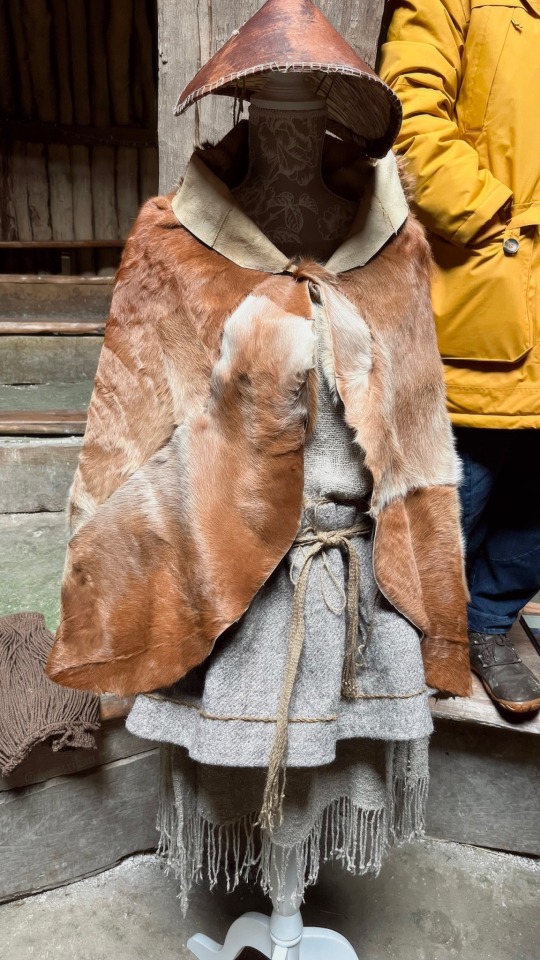






A lovely weekend at Dorset’s Ancient Technology Centre for a fantastic Heritage Textiles course hosted by Castle Hill Heritage! We looked at textiles and their production methods from the Palaeolithic to the Industrial Revolution!
#durotrigan#textiles#bog fashion#prehistoric textiles#historical textiles#reenactment#sally pointer#vanessa bunton#jalea ward#drakos dottir#nicole derushie#norse#bog body#weaving#tablet weaving#loom#twining#prehistory#exarc#experimental archaeology#anthropology#ancient technology centre#otzi the iceman#ötzi#natural dyes
240 notes
·
View notes
Text





𝐔𝐧𝐥𝐨𝐜𝐤 𝐭𝐡𝐞 ����𝐞𝐜𝐫𝐞𝐭𝐬 𝐁𝐞𝐡𝐢𝐧𝐝 𝐋𝐮𝐱𝐮𝐫𝐢𝐨𝐮𝐬 𝐅𝐚𝐛𝐫𝐢𝐜𝐬: 𝐃𝐢𝐯𝐞 𝐢𝐧𝐭𝐨 𝐅𝐚𝐛𝐫𝐢𝐜 𝐅𝐢𝐧𝐢𝐬𝐡𝐢𝐧𝐠 𝐓𝐞𝐜𝐡𝐧𝐢𝐪𝐮𝐞𝐬
Discover how fabric finishing transforms raw textiles into luxurious materials. Explore essential techniques like scouring, bleaching, and mercerizing that enhance texture, appearance, and performance. Learn about mechanical processes such as calendering and raising, and chemical treatments that impart wrinkle resistance and water repellency. This comprehensive guide offers insights into the art and science behind the fabrics we use daily, making it indispensable for textile enthusiasts and professionals alike.
Regards, Fashion Articles by Waves Fashion Institute
#fabric#fabric processing#textile#textile industry#fabric care#textile innovation#textile technology#textile manufacturing#fabric finishing#fashion#fashion design#textile science#fabric science#dyeing#printing#painting#cleaning
0 notes
Text
Four-Cornered Hats from Peru and Bolivia, c.600-800 CE: these colorful, finely-woven hats are at least 1,200 years old, and they were crafted from camelid fur

Above: four-cornered hats made by the Wari Empire of Peru (top) and the Tiwanaku culture of Bolivia (bottom) during the 7th-9th centuries CE
Often referred to as "four-cornered hats," caps of this style were widely produced by the ancient Wari and Tiwanaku cultures, located in what is now Peru, Bolivia, and Chile.
According to the Metropolitan Museum of Art:
Finely woven, brightly colored hats, customarily featuring a square crown, four sides, and four pointed tips, are most frequently associated with two ancient cultures of the Andes: the Wari and the Tiwanaku. The Wari Empire dominated the south-central highlands and the west coastal regions of what is now Peru from 500–1000 A.D. The Tiwanaku occupied the altiplano (high plain) directly south of Wari-populated areas around the same time, including territory now part of the modern country of Bolivia.

Above: pair of four-cornered hats made by the Wari people of Peru, c.600-900 CE
Both cultures used the hair of local camelids (i.e. llamas, alpacas, or vicuñas) to produce their hats. The hair was harvested, crafted into yarn, and treated with colorful dyes, and the finished yarn was then woven and/or knotted into caps and other textiles. Four-cornered hats from both cultures were often decorated with similar stylistic elements, including geometric patterns (particularly diamonds, crosses, and stepped triangles) and depictions of zoomorphic figures such as birds, lizards, and llamas with wings.

Above: four-cornered hats made by the Tiwanaku people of Bolivia, c.600-900 CE
The two cultures used different techniques to construct/assemble their hats, however:
Although they shared certain technological traditions, such as complex tapestry weaving and knotting techniques, the Wari and the Tiwanaku utilized significantly different construction methods to create four-cornered hats. Wari artists typically fashioned the top and corner peaks as separate parts and later assembled them together. Tiwanaku artists generally knotted from the top down, starting with the top and four peaks, to create a single piece.
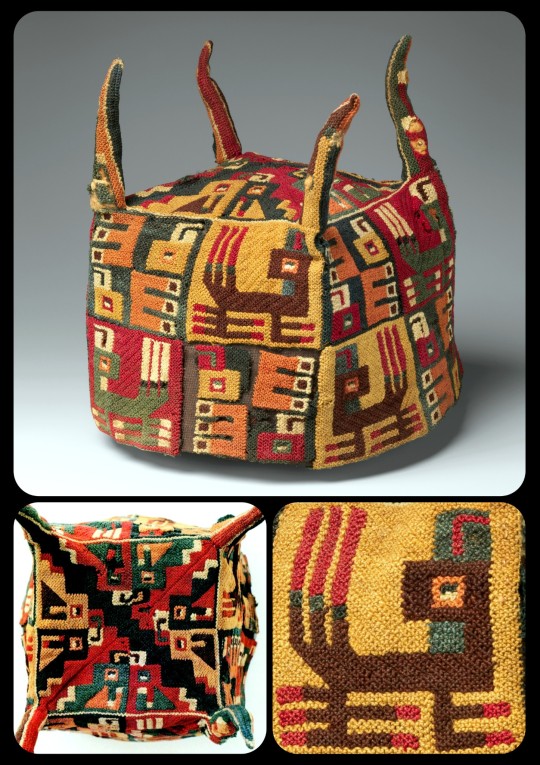
Above: a four-cornered hat from Bolivia or Peru, made by either the Tiwanaku or Wari culture, c.500-900 CE
There is evidence to suggest that four-cornered hats were often worn as part of daily life, as this publication explains:
Many have indelible marks of hard usage: wear along the edges and folds, a crusting of hair oil on the inside, remnants of broken chin ties, and ancient mends.

Above: a pair of hats made by the Wari culture of Peru, c.600-800 CE

Above: more hats from the Wari culture of Peru, c.700-900 CE, with colorful tassels decorating the four peaks of each cap
The oldest known/surviving examples of the Andean four-cornered hat date back to nearly 1,700 years ago. They began to appear along the northern coast of Chile at some point during the 4th century CE; these early hats had an elongated design with four short peaks, and they are typically associated with the Tiwanaku culture.
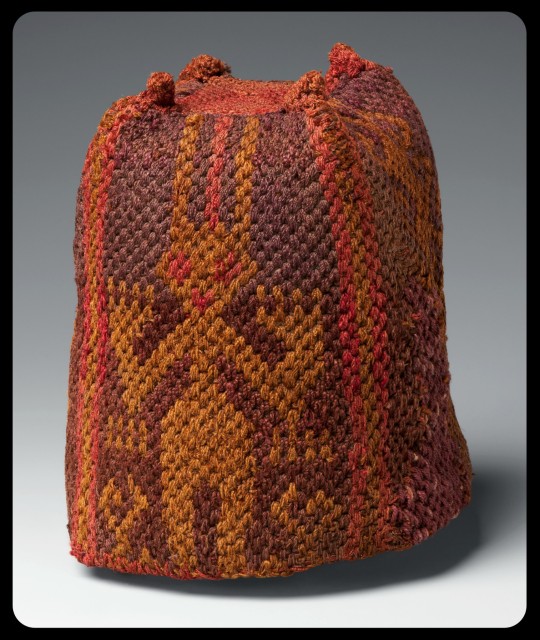
Above: this early example of a four-cornered hat was created by the Tiwanaku culture between 300-700 CE
Why indigenous artifacts should be returned to indigenous cultures.
Sources & More Info:
Metropolitan Museum of Art: Four-Cornered Hats 1, 2, 3, 4, 5, 6, 7, 8, 9, 10, 11, and 12
Museum Publication: Andean Four-Cornered Hats (PDF available here)
Emory University: Four-Cornered Pile Hat
Metropolitan Museum of Art: Andean Textiles
#archaeology#artifact#anthropology#history#four-cornered hat#tiwanaku#wari#art#textile art#hats#peru#bolivia#precolumbian#andes#alpaca#fiber art#crafting#pile hats#ancient textiles#indigenous art
207 notes
·
View notes
Text
We need a manga/anime in the hobby-interest subgenre that’s a love letter to fibre crafts.
Let me explain. Stuff like My Dress-Up Darling and Negative-Positive Angler fall into a subgenre I’m calling “hobby interest.” They have a broader overarching genre (romance and slice-of-life, respectively) but base their character interactions and initial draw gimmick around appreciation of a specific hobby (sewing/cosplay and fishing, respectively).
And don’t even get me started about the million-and-one cooking anime out there, a number of which (significant to this proposal) are isekai or I-cant-believe-it’s-not-isekai (those fish-out-of-water generico fantasy series that are one pre-opening-credits flashback about the protag’s former life away from being actual isekai).
And so I circle back to my main point: we need one of these that’s about traditional methods of fibre farming, processing, and crafting.
An isekai actually works well as a purposeful framing device here, as our speculative protag (let’s make them a woman as fibrecrafts are “traditionally” women’s work and I want that gender stuff genuinely acknowledged and appreciated) could have a point of reference to modern fibrecrafts - perhaps she was a hobby knitter herself, - and draw comparisons for the benefit of the audience.
We could call it something generic like “Weaver’s Apprentice in Another World” to really fit the trash isekai appearance.
The focus should be on highlighting the entire process of fibre-creation. From the start of farming, with episodes about sheep and silkworm husbandry, about flax and cotton farming. To processing; carding, extracting, spinning - silk farming in particular has a huge history that would be interesting to delve in to. The many methods of creating; the titular weaving (of which there are many methods and styles!), knitting, crochet. Obtaining, processing, and using dyes…
All this being a great way to appreciate different cultural textiles too! A Japanese audience may have a base appreciation for all the work that goes into a handmade kimono, but what about hand-painted fabrics and batiks? What about a highland tartan? An isekai framing works well here too, using the idyllic multiculturalism of a fantasy world to access different analogues to real-world cultures.
You see the potential here, right? And all through this the protag can be comparing what she’s seeing and learning to how a lot of this has been relegated to hobby status in the modern day, how synthetic fibres and automation and fast fashion have distanced people from the cloth they wear. (Not all of which is a bad thing; automated weaving is an amazing technology, etc. We can even get a little history lesson about the very real apprehensions surrounding the automated loom as well!)
Anyway this is all just me vamping - I think it’s a great idea but I hardly have the resources or skills to do anything with it. If you’re someone out there that has a way to run with this concept, go for it. I’d read/watch the hell out of something like this.
#sable has a take#sable talks about media#fibre crafts#fibre arts#anime tropes#concepts#weaving#knitting#crochet#anime#anime and manga#alternately if this or something like it already exists hit me up! I’d love a rec!
126 notes
·
View notes
Text







The first major solo museum presentation of fourth-generation Navajo weaver Melissa Cody (b. 1983, No Water Mesa, Arizona) spans the last decade of her practice, showcasing over 30 weavings and a major new work produced for the exhibition. Using long-established weaving techniques and incorporating new digital technologies, Cody assembles and reimagines popular patterns into sophisticated geometric overlays, incorporating atypical dyes and fibers. Her tapestries carry forward the methods of Navajo Germantown weaving, which developed out of the wool and blankets that were made in Germantown, Pennsylvania and supplied by the US government to the Navajo people during the forced expulsion from their territories in the mid-1800s. During this period, the rationed blankets were taken apart and the yarn was used to make new textiles, a practice of reclamation which became the source of the movement. While acknowledging this history and working on a traditional Navajo loom, Cody’s masterful works exercise experimental palettes and patterns that animate through reinvention, reframing traditions as cycles of evolution. Melissa Cody is a Navajo/Diné textile artist and enrolled member of the Navajo/Diné nation. Cody grew up on a Navajo Reservation in Leupp, Arizona and received a Bachelor’s degree in Studio Arts and Museum Studies from Institute of American Indian Arts, Santa Fe. Her work has been featured in The Barnes Foundation, Philadelphia (2022); Crystal Bridges Museum of American Art, Bentonville, AR (2021); National Gallery of Canada, Ottawa (2019–2020); Museum of Northern Arizona, Flagstaff (2019); SITE Santa Fe (2018–19); Ingham Chapman Gallery, University of New Mexico, Albuquerque (2018); Navajo Nation Museum, Window Rock (2018); and the Museum of Contemporary Native Arts, Institute of American Indian Arts, Santa Fe (2017–18). Cody’s works are in the collections of the Stark Museum of Art, Orange, Texas; the Minneapolis Institute of Arts; and The Autry National Center, Los Angeles. In 2020, she earned the Brandford/Elliott Award for Excellence in Fiber Art.
Melissa Cody: Webbed Skies currently on exhibition at MoMA PS1 through September 9nth, 2024
IDs Under the cut
Top to Bottom, Left to Right: White Out. 2012. 3-ply aniline dyed wool. 17 × 24″ (43.2 × 61 cm)
Deep Brain Stimulation. 2011. Wool warp, weft, selvedge cords, and aniline dyes. 40 x 30 3/4 in. (101.6 x 78.1 cm)
World Traveler. 2014. Wool warp, weft, selvedge cords, and aniline dyes. 90 x 48 7/8 in. (228.6 x 124.1 cm)
Into the Depths, She Rappels. 2023. Wool warp, weft, selvedge cords, and aniline dyes. 87 x 51 9/16 in. (221 x 131 cm)
Lightning Storm. 2012. 3-ply aniline dyed wool. 14 × 20″ (35.6 × 50.8 cm)
Pocketful of Rainbows. 2019. Wool warp, weft, selvedge cords, and aniline dyes. 19 x 10 3/4 in. (48.3 x 27.3 cm)
Path of the Snake. 2013. 3-ply aniline dyed wool. 36 × 24″ (91.4 × 61 cm)
351 notes
·
View notes
Text
Preface this that this is about Destiny 2, a video game, so none of this actually matters. Just hypothetical ravings of a fiber artist with a bit of knowledge about historical things. So like I keep having thoughts about textile production during the dark ages after the collapse. (Specifically at Felwinter's Peak, but hold that thought). We have such varied descriptions of what survived the collapse. People are depicted as wearing basic tunics and dresses that would not look out of place at an SCA event. Technology is primitive, except they still have guns that they up keep and have ammo for, Shaxx is described as sealing his keep with an artificial sealant. So things are so varied and random. Like did spinning wheels exist still? They obviously don't have access to industrial machines, but are they just spinning everything on drop spindles? (Making me question how much work it would take to keep all the freaking iron lords and wolves on that mountain clothed.) For that matter, do they still have acid dyes? Or are they relying on natural dyes? Dye materials used to be highly valued, you can't tell me warlords wouldn't be fighting over this stuff (which also brings up Spices being fought over likewise). I mean you could hand wave everything by saying "golden age technology", but that shouldn't be half an interesting. We do have the Strand lore book where Osiris talks about using a spindle when during the dark age they had to make everything from scratch, which supports that line of reasoning. So no spinning wheel, only spindles. Cloth production takes so much freaking time when doing everything from scratch. With a spinning wheel it takes me hours to produce a few hundred yards of a thicker yarn for knitting, I'm not incredibly experienced, but it takes so incredibly much more time on a spindle. And you need so much yarn to be able to weave cloth of any yardage. There's a reason women in paintings used to be depicted with spindles and distaffs so often. For that matter, what sorts of looms were they using? If they didn't have spinning wheels I'm guessing advanced looms are out as well. So rigid heddle looms? Warp weighed looms? The second would make more sense, but also takes so much time and you can only weave cloth so wide. It's limited by the arm span of the weaver. So narrow fabric, so even more yardage needs to be made. We're not even at the sewing stage yet. I discussed dyes earlier, but it would be important. Even in the actual medieval times clothes weren't all brown. Natural dyes tend to fade faster though. Black dyes were really hard to produce, and they fade fast. Then sewing would be by hand, I doubt there are sewing machines if they don't even have spinning wheels. Sewing by hand takes *forever* even if you are fast. There are tricks to making it go fast, but you're not producing an entire garment in a day, especially if you have anything else going on. For that matter you really care about mending in this environment. Also knitting and crochet? Technically those take longer to produce a garment than weaving and sewing. I know Zavala learned knitting from Safiya in the dark ages, so it did survive.
I think I'm at the end of my ramble, I'll add if I can think of anything else. I'd love to hear other people's opinions.
#destiny 2#this is a stream of thought sorry in advance#fiber arts#sorry for all one paragraph I'm on mobile
62 notes
·
View notes
Text
Nobody wants to hear it but you really need to start paying attention to care instructions on clothes and taking care to wash them properly.
A 80 years ago clothing was expensive and hard to make, that separating colors, materials, etc was imperative to keep them in the best condition.
In the past decade or two we've lost this knowledge.
This can be attributed, in my opinion, to advances in textile and detergent technology that caused less damage to our clothes with the default washing and drying method.
Now, we've looped to the other extreme, where clothes are mass produced so cheaply that any mistake in washing them will cause them to shred and wear faster. Fabric is thinner, dyes are less steadfast, elastic is cheaper.
People need to start taking care of their clothes again. and its a sign of how capitalism is "working" that I think gets overlooked entirely.
52 notes
·
View notes
Photo
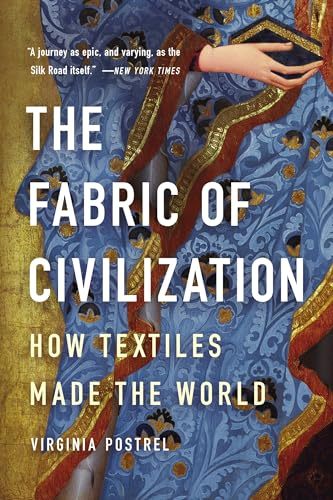
The Fabric of Civilization: How Textiles Made the World
In "The Fabric of Civilization," Virginia Postrel explores how the history of textiles is akin to the story of civilization as we know it. As evidenced throughout her book, Postrel treats each chapter as a standalone story of its production and journey, all the while masterfully weaving it together to show the story of human ingenuity. While academic in nature due to its incredibly well-researched methodology, the general reader will enjoy the book's unique style and approach to world history.
In The Fabric of Civilization: How Textiles Made the World, Virginia Postrel expertly demonstrates how the history of textiles is the story of human progress. Although textiles have shaped society in many ways, their central role in the development of technology and impact on socio-economics have been exceedingly overlooked. Attempting to remedy this issue, Postrel organizes her book into two distinct sections: one focusing on the different stages of textile production (fiber, thread, cloth, and dye) and the other on the consumers, traders, and future innovators of said textiles. To strengthen her argument, Postrel pulls from different primary sources across many regions and cultures, such as the works of people like entomologist Agostino Bassi and the accounts of disgruntled Assyrian merchants. However, Postrel goes beyond relying solely on books and peer-reviewed articles; she personally interviewed textile historians, scientists, businesspeople, and artisans who offered their own insight regarding the importance of textiles in the world. To help the reader envision the intricacies of textile manufacturing, the book is riddled with images that range from ancient spindle whorls and Andean textile patterns to nineteenth-century pamphlets raging over improved cotton seeds. It is quite a laborious task to explain the history of textiles, but Postrel’s way of organizing her chapters and style of writing does an excellent job of conveying her argument.
In Chapter One, Postrel illustrates the many uses of fibers and how their multipurpose functionality served its role in world economies. From the domestication of cotton in the Americas to sericulture in ancient China, such fibers left an indelible mark on trade and technology. Chapter Two looks at the use of thread's connection with social and gender roles as Postrel argues that dismissing fabric as feminine domesticity ignores its integral role in the social innovations that products like clothing and sails provided. Chapter Three connects mathematics with weaving through handwoven textiles by Andean artisans and in the notations written down in Marx Ziegler’s manual, The Weaver’s Art and Tie-Up Book (1677). Chapter Four explains how dyes not only contributed to the distinction between social classes, such as the use of Tyrian purple by Roman emperors but also the ingenuity of humans to ascribe meaning and beauty to a variety of colors. Furthermore, the increasing and competitive trading of dyes in the 16th and 17th centuries would eventually contribute to the discovery of synthetic dyes.
Textile traders and consumers also helped to foster cultural exchanges. Postrel then highlights how traders often also served as innovators. The implementation of the Fibonacci sequence in European trading not only helped traders with bookkeeping but also gave a new perspective to the practicality of learning math by helping traders understand profits and calculate prices. Readers explore in Chapter Six how the Mongol Empire expanded across many different lands for their desire for valuable woven textiles. Under the Pax Mongolica, the textile trade flourished as the Mongols protected the Silk Road, resulting in cross-cultural and technological exchange between Europe and Asia. Lastly, in Chapter Seven, Postrel introduces synthetic polymers like nylon and polyester, where the efforts made by scientists like Wallace Carothers, Rex Whinfield, and James Dickson have revolutionized the use of textiles. Companies like Under Armour use polyester to create water-repellent clothing. Despite synthetic polymers currently being used innovatively, many still seek to look into the future of textiles. As Postrel explains, imagine your pockets can charge your phone or your hat could give you directions. The future of textiles is incredibly exciting.
As an avid writer of socio-economics, Postrel expertly showcases her knowledge of the subject. Postrel’s previous books, such as The Future and its Enemies (1998) and The Power of Glamour: Longing and the Art of Visual Persuasion (2013), cover the interconnectedness between culture, technology, and the economy. Postrel has also worked as a columnist for several news sites, is the contributing editor for the magazine Works in Progress, and was a visiting fellow at the Smith Institute for Political Economy and Philosophy at Chapman University. This book is a wonderful intellectual contribution that feels like a documentary series, perfectly threading the reader through cultures and regions like a needle through fabric.
Continue reading...
93 notes
·
View notes
Text
Dyes widely used in the textile, food and pharmaceutical industries pose a pressing threat to plant, animal and human health, as well as natural environments around the world, a new study has found. Billions of tons of dye-containing wastewater enter water systems every year, and a group of researchers from the UK, China, Korea and Belgium say that new sustainable technologies including new membrane-based nano-scale filtration are needed to solve the issue, adding that legislation is needed to compel industrial producers to eliminate colorants before they reach public sewage systems or waterways. Published today in Nature Reviews Earth & Environment, the study Environmental impacts and remediation of dye-containing wastewater was written by academics from the University of Bath, the Chinese Academy of Sciences, the Fujian Agriculture and Forestry University, the Korea Institute of Energy Technology (KENTECH), and KU Leuven, Belgium. The research highlights that currently, up to 80% of dye-containing industrial wastewaters created in low- and middle-income countries are released untreated into waterways or used directly for irrigation. The authors say this poses a wide range of direct and indirect threats to human, animal and plant health
Continue Reading
123 notes
·
View notes
Text
So anyway,
Tempest and Textiles
As a growing adolescent bodyguard who frequently got blood on his clothes, Tempest decided that wearing black was a better option than appearing in public beside Caspar while wearing obvious bloodstains. This being a country with Renaissance-level technology, black fabric mainly appears in the form of naturally black wool.
Pro: it’s cheaper because it really can’t be dyed any color except More Black
Con: availability is limited to whatever the livestock produce
After returning to his home kingdom, Caspar tried to impress upon his bodyguard/bff that he needed actual court attire now. Tempest said “ugh, fine” and set out to make it happen in shades of black. He had some knowledge of alchemy from his magic studies, and was already on friendly terms with the spinners and weavers who supply his black wool. They introduced him to their dye-witch friends (yes, the dyers in this country are called dye-witches, because it looks magical). He worked with them for years to create dye recipes for black satin and velvet and so on. Tempest is now widely popular with the workers at every level of textile production, and he’s the only person who doesn’t have to pay luxury prices for the ✨Latest New Black✨ that he’s definitely helped make popular anyway, just by existing close to Caspar. (Caspar himself infuriates the majority of his noble cousins by preferring to dress like a merchant for all but the most formal of occasions, but that’s not relevant to this post.)
To recap: Tempest has an edgelord name that he acquired mostly by accident, he has an edgelord wardrobe that he acquired half out of pragmatism, and he prefers to kill with his hands rather than magic, even though by his mid-twenties he could just vaporize people with the power of his mind if he wanted to. Oh, yeah, and there’s that wing kink.
12 notes
·
View notes
Text
Jig Dyeing Machines Market set to hit $1203.4 million by 2035
The global Jig Dyeing Machines market is poised for significant growth, with industry revenue projected to rise from $521.4 million in 2024 to $1203.4 million by 2035, reflecting a compound annual growth rate (CAGR) of 7.9% from 2024 to 2035.
Detailed Analysis - https://datastringconsulting.com/industry-analysis/jig-dyeing-machines-market-research-report
Jig Dyeing Machines are essential in the textile industry, playing a crucial role in applications such as fabric dyeing, garment dyeing, industrial material dyeing, and home textiles. The market's growth is primarily driven by the increasing demand for automated textile dyeing solutions and the emergence of sustainable dyeing technologies.
Competitive Landscape and Market Leadership
The Jig Dyeing Machines industry is highly competitive, with several key players leading innovation and market penetration. Major companies in this space include:
Benninger
Singularity
Bosen
Fong's National Engineering
Thies
Loris Bellini
Brazzoli
Sclavos
A.T.E. Enterprises
Goller
Tong Geng Enterprise
Tecnorama
These companies are investing heavily in research and development to introduce energy-efficient, sustainable dyeing solutions and improve automation capabilities. This ongoing innovation is helping them maintain leadership in the market.
Key Growth Drivers and Market Opportunities
Several factors are driving the growth of the Jig Dyeing Machines market:
Technological Advancements: Innovations in dyeing machine technology are increasing efficiency, reducing water and energy consumption, and improving dyeing quality.
Sustainability Focus: The rise of eco-friendly dyeing solutions, such as reduced chemical use and water recycling, is creating significant opportunities for market growth.
Automated Dyeing Solutions: Increased demand for automation in textile manufacturing is pushing the adoption of advanced jig dyeing machines.
Expanding Textile Industry: The growing textile industry in developing economies is driving demand for high-efficiency dyeing machinery.
Sustainable Production: Manufacturers are focusing on developing dyeing machines that comply with environmental regulations and sustainability standards.
Emerging Markets and Regional Shifts
North America and Europe remain the most active regions in the Jig Dyeing Machines market, with established textile industries and strong regulations supporting sustainable practices. However, emerging markets such as China, India, Vietnam, South Africa, and Colombia are becoming increasingly important for revenue diversification and market expansion. These regions offer significant growth potential due to rising industrialization, increased demand for textiles, and growing environmental concerns.
As the market faces challenges related to high initial investment, maintenance costs, and regulatory compliance, the supply chain is expected to evolve. Companies will focus on improving their supply chain efficiencies and exploring new markets to maximize growth opportunities.
About DataString Consulting
DataString Consulting is a trusted provider of market research and business intelligence solutions, offering comprehensive services for both B2C and B2B markets. With over 30 years of combined industry experience, DataString specializes in delivering actionable insights that help businesses make informed, strategic decisions.
The company’s expertise spans multiple industries, and it provides tailored research services in areas like strategy consulting, opportunity assessment, competitive intelligence, and market forecasting. DataString Consulting helps clients navigate complex markets and capitalize on emerging trends to achieve long-term success.
#Jig Dyeing Machines#Textile Industry#Market Growth#Sustainable Dyeing Solutions#Automated Textile Dyeing#Dyeing Technology#Textile Machinery#Fabric Dyeing#Garment Dyeing#Industrial Material Dyeing#Home Textiles#Energy-Efficient Dyeing#Eco-Friendly Dyeing#Textile Manufacturing Automation#Emerging Markets#Industrialization#Global Market Trends#Competitive Landscape#Technological Advancements#Market Forecast#DataString Consulting#Textile Machinery Market#Sustainability in Manufacturing#Market Research
0 notes
Text
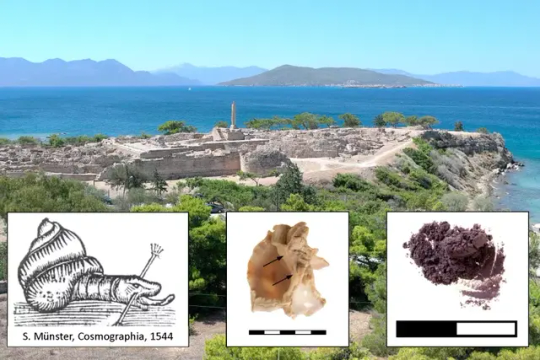
In This Ancient Workshop, Greeks Crushed Snail Glands to Make the Purple Dye Worn by Royalty
Archaeologists discovered remnants of a 3,600-year-Old Dye factory on an island in Greece.
On an island in Greece, researchers have discovered a 3,600-year-old workshop that once turned out a rare purple dye coveted by royalty—and made from snail glands.
Archaeologists were excavating recently in the Bronze Age town of Kolonna, on the Greek island of Aegina, when they discovered two Mycenaean buildings. As the researchers write in a study published in the journal PLOS ONE, the buildings date to the 16th century B.C.E., and the older one contained pigmented ceramics, grinding tools and heaps of broken mollusk shells: all indicative of a purple dye factory.



In this workshop, ancient Greeks produced the vibrant pigment known as Mycenaean purple—or, as the Romans called it, Tyrian purple. First manufactured by the Phoenicians in present-day Lebanon, the dye was extracted from the mucus of the Mediterranean’s carnivorous sea snails. Across the region, only the rich owned anything dyed Mycenaean purple, as the color’s production was painstaking.
As Roman historian Pliny the Elder once wrote, thousands of snails were required to produce a single ounce of purple dye. Its creators had to crush snails’ shells, extract their tiny glands, mix them with salt water and let the concoction steep in the sun, per the study. The result was a “deep purple, lilac or dark red color,” which was used on textiles and paintings, study co-author Lydia Berger, an archaeologist at the University of Salzburg, tells Popular Science’s Laura Baisas.
The fragments of pottery the researchers found on the site were probably containers for dye. As Berger notes, the pottery’s pigments are so high-quality that they could still be extracted and used to dye clothing today. The site also contained stones used for grinding, a waste pit and piles of crushed snail shells.
Eventually, snail purple would become the color of royalty. In the first century C.E., Roman Emperor Julius Caesar named Tyrian purple his official color and inspired successive emperors to don the same hue. But back in the 1500s B.C.E., the color was just beginning to be produced.


At the time, Kolonna was a dense, fortified small town, says Berger, whose inhabitants produced and traded lots of different handcrafted products and raw materials like Mycenaean dye, which wasn’t yet exclusive. Though the dye factory is in an urban area—an oddity among dye workshops—its coastal location is ideal for purple production. As the researchers write, snails had to be caught and kept alive until their glands were harvested.
By analyzing the shells in this particular workshop, researchers concluded that just one snail species was used there: the banded dye-murex. Interestingly, it wasn’t the only animal killed at the site. As Newsweek’s Aristos Georgiou writes, archaeologists also found the burnt bones of several piglets and lambs. Researchers suggest these young mammals were sacrificed in the workshop as part of a ritual, meant to somehow bless the dye’s production.
As they write in the study, the ancient site not only proves that purple dye was manufactured in cities, but also provides “new insights into the technological and possibly spiritual background of the process.”
By Sonja Anderson.



#Archaeologists Discovered Remnants of a 3600-Year-Old Purple Dye factory in Greece#Bronze Age town of Kolonna#Greek island of Aegina#purple#Mycenaean purple#Tyrian purple#ancient artifacts#archeology#archeolgst#history#history news#ancient history#ancient culture#ancient civilizations#ancient greece#greek history
25 notes
·
View notes
Text
On Altmeri textiles...
Altmer culture is permeated by textiles. Textile art is the most prevalent form of Altmer Art outside of Summerset, and it includes tapestries; utilitary textiles like rugs, bedcovers, dividers and elaborate shawls; its main forms are plant fibers such as jute fiber, papires, wicker and cotton, insect fiber (less common than in Morrowind, obviously) like spidersilk and silkworm silk, and livestock fiber such as wool, and indrik fibers. Altmer have been inventive about where they get their fibers and so it is not uncommon to see fibers made from things that would possibly shock other folks considered the pinnacle of crafting prowess in the isles. A good tapestry artist can even dye sinew and incorporate it into their work, it is said. Much of their work is aided by magic or mechanisms like the spinning wheel, and they highly value vibrant pigments. The brighter the color, the higher the caste, and as such there have been color restrictions in place depending on one's station.
They prefer preciousness and detailed work to sturdy textiles due to the weather of the Isles, but Altmer outside Summerset are known to take pride in using their inherited techniques to make warm garments just as easily.
Light and semi-transparent fabrics are held in high esteem, and folding them to achieve brighter colors has led to layered yet cool outwear made of tulle similes and shining silks in the shapes of togas. In fact, much of their clothes are elaborate in their simplicity, since they consist of a single piece of fabric with minimal stitching, folded to taste and ancestral/family customs. Some families have their signature way of dressing, which can include patterns, ways of layering clothes, or even the fabric and its colors.
Adornments are highly valued and it's not unlikely to see an Altmer in brocaded clothes, laden with jewelry usually embellished with aetherquartz and culanda, as well as other more typical stones.
The fact that they're so traditional has led to tremendous technological leaps in the improvement of family techniques being often zealously guarded, and, as a result, certain textile artists are seen as artist-gods for their irreplicable work. Possession of one such garment or piece made by these lineages of masters is a sign of station and prestige
#tesblr#fanficblr#tes headcanons#altmer#worldbuilding#elder scrolls lore#my writing#my hcs#orfeoarte
104 notes
·
View notes
Text
Heritage News of the Week
Discoveries!
During a diving expedition in the Nile River, archaeologists in Egypt discovered rock carvings featuring depictions of several ancient Egyptian pharaohs, along with hieroglyphic inscriptions.
Bronze Age axe found off Norway’s east coast
The axe was discovered at a depth of 12 metres during a routine survey for the Norwegian Coastal Administration. It was found on the seabed in an accumulation of beach-rolled flint lumps and has been identified as a hollow axe made of Bronze from 1100 BC.
2,700-year-old military Roman port found in Parion, Türkiye
Underwater studies in Parion, a 2,700-year-old port city from the Roman Empire in Kemer village of Biga district of Çanakkale in northwestern Türkiye, revealed the second ancient port of the city.
Maya structures and pyramids discovered among Mexican tropical forests
Among Mexico’s dense tropical forests in central Campeche, archaeologists have identified pyramids and a ceremonial center, as well as a subterranean structure beneath a ball court constructed by the ancient Maya.
Earthquake at same time as eruption could have caused Pompeii deaths – study
Victims who perished in Pompeii after the devastating AD79 eruption of Mount Vesuvius may have been killed by a simultaneous earthquake, research has suggested.
Marvelous marble floor of sunken Roman villa restored in Bacoli
In Bacoli, Italy, an underwater restoration project has uncovered the marvelous marble floor of a submerged Roman villa. This remarkable find is part of an ongoing excavation by CSR Restauro Beni Culturali and Naumacos Underwater Archaeology and Technology at the Submerged Archaeological Park of Baiae, which aims to illuminate the most historically significant underwater region of the Roman Empire.
Viking arrowhead found frozen in ice
Archaeologists from the “Secrets of the Ice” project have discovered a Viking Era arrowhead during a survey of an ice site in the Jotunheimen Mountains.
Humans reached Argentina by 20,000 years ago — and they may have survived by eating giant armadillos, study suggests
The discovery of butchered bones belonging to a glyptodont, a giant relative of the armadillo, suggests that humans were living in Argentina 20,000 years ago.
Archaeologists discover traces of Roman circus at Iruña-Veleia
In a recent study using aerial photography and light detection and ranging (LiDAR), archaeologists have found a Roman circus and previously unknown urban areas of Iruña-Veleia.
An unexpected discovery in Pompeii: A Roman tomb reveals the existence of an unknown imperial position in Hispania
A surprising discovery in Pompeii gives us new information about the history of Spain between the 1st century B.C. and the 1st century A.D. The inscription on the tomb tells us of a brilliant military career followed by a quiet retirement in Pompeii, now a symbol of world archaeology, at the time a town in Campania renowned for the beauty of its landscape and views of the Gulf of Naples.
Archaeologists make new discoveries at Bodbury Ring hillfort
Archaeologists from Time Team and the Universities of Chester and York, recently conducted a study of Bodbury Ring using light detection and ranging (LiDAR). The study has revealed that Bodbury Ring is six times larger than previously thought and is part of a much larger hillfort which enclosed the entirety of the ridgetop on Bodbury Hill.
A 4000-year-old fabric found in a cave of skulls in the Judean Desert is the oldest dyed with insect dye
This textile, found in the Judean Desert and made of linen and wool dyed red, has been dated by direct radiocarbon to the Middle Bronze Age, specifically between 1954 and 1767 BC. What makes this find unique is the use of red dye derived from the insect Kermes vermilioa luxurious and rare source of color in ancient times.
Lost crusader altar discovered in holiest site of Christendom
Archaeologists from the Austrian Academy of Sciences (ÖAW), working in collaboration with the Israel Antiquities Authority (IAA), have discovered a lost crusader altar in the Church of the Holy Sepulchre.
The story of how they found this is hilarious. There was just a big stone slab leaning against the wall, covered in graffiti, and one day someone wondered what was on the other side.
Study reveals interior of Egyptian mummified crocodile
Scientists have used state of the art 3D imaging technology to piece together the life - and probable death - of a 2.2 metre-long crocodile mummified by the ancient Egyptians.

Medieval royal ring unearthed in Bulgaria
A ring has been found in a grave in a church at the site of Kokaliansku Urvich, a medieval fortress. The ring, found on the remains of the person’s hand, bears an image of an eagle, a medieval symbol of royal power, and is thought to link the wearer to the Bulgarian king Ivan Alexander. A rosette on the ring is thought to symbolize continuity and ancestral memory.
1,800-year-old ring depicting Roman goddess discovered by ancient quarry in Israel
A teenager hiking in northern Israel unexpectedly discovered an 1,800-year-old ring adorned with an engraving of a Roman goddess holding a sword and spear.
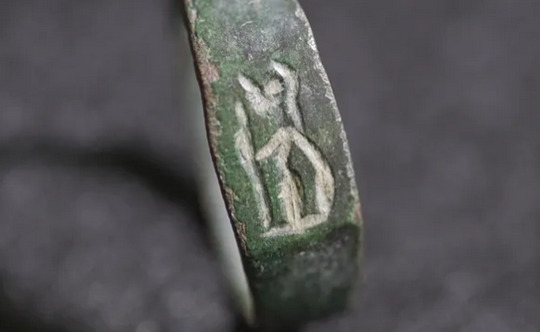
Underwater archaeologists find 112 glassware objects off Bulgaria’s coast
In the latest study, 112 whole and fragmented glass vessels were discovered, providing new insights into the trade and production in the Balkans during the Late Ottoman period.
Bones of fallen 19th-century Polish soldiers unearthed in Slovakia
The remains of six Polish soldiers killed in eastern Slovakia during the Battle of Budimír on December 11, 1848, have been unearthed by researchers from the East Slovak Museum,
Paper cuttings made by 17th-century schoolgirls discovered beneath floorboards
In the 17th century, girls attending a London boarding school learned to make decorative paper cuttings. Several of these creations—including a tiny fox, a star and a hen—survived for 350 years beneath the floorboards of Sutton House, a historic building that once functioned as a school for upper- and middle-class girls.
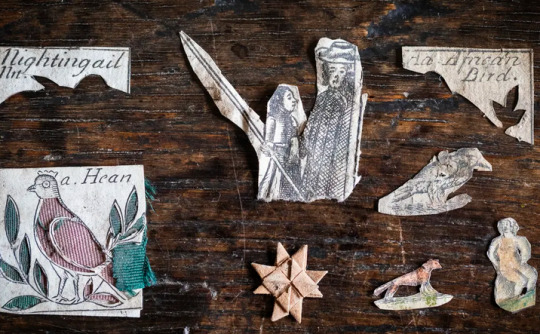
A mysterious human face carved on stone dated to Bronze Age discovered in Kazakhstan
A mysterious archaeological find has been uncovered in the Akmola Region of Kazakhstan. Employees of the Regional Emergency Situations Department came across a historical find in the form of a human face carved into stone and invited archaeologists to examine the artifact.
Museums
The public museum situated at the People’s Square announced last week that visitors will be allowed to bring their cats to a special series of events commemorating its forthcoming Egyptian antiquities exhibition, according to multiple reports from state-controlled news outlets.

This has nothing to do with the above story except that it involves cats. I just wanted an excuse to use it.
V&A beats out Met Museum to acquire $2.6m ivory sculpture of Christ
The Victoria & Albert Museum, also known as the V&A, recently raised the $2.6 million (£2 million) needed to acquire and save a 12th-century walrus ivory carving after a temporary export ban last November.
Colombian museum housing scientifically important fossils may close
For paleontologists studying the Miocene period in South America, which started about 23 million years ago and saw mammals diversifying in a warming world, a simple building in the town of La Victoria in the La Venta region of Colombia is a key destination. There, the Natural History Museum of La Tatacoa houses about 4000 well-preserved and often complete skeletons of animals, including Colombia’s biggest collection of ancient primates and specimens of rare ancient bats. But poor roads, which wash out when it rains, have reduced tourism and revenue and may force the museum to close.
London’s Science Museum ends contract with oil sponsor after protests
London’s Science Museum Group, a collective of five UK-run museums, has ended a sponsorship deal with the oil company Equinor after calls for its board to divest from the energy giant.
New funding brings Marines museum a step closer
A 19th century boathouse is a step closer to being transformed into a museum, following a multi-million pound cash infusion.
Brazilian artist steals historic coin from the British Museum as part of art project
Last month, the Brazilian artist Ilê Sartuzi stole a historic coin from its display case at the British Museum in London, and shortly after dropped the coin in the museum’s donation box, the Art Newspaper reported Monday.

Repatriation
The University of Iowa Stanley Museum of Art has become the first in the United States to restitue its holdings of Benin Bronzes, to the Oba of Benin, the former head of the royal family of Benin and steward of its legacy. Two objects, a brass plaque and wooden altarpiece, were formally returned in a ceremony held on July 15 at the Benin Palace in Nigeria.
New British Museum director says he has ‘hope’ for partnership with Greece on Parthenon Marbles
Nicholas Cullinan, the new director of London’s embattled British Museum, spoke this week of the possibility of an official agreement with Greece on the Parthenon Marbles, providing yet another sign that the institution is far more amenable than it used to be in resolving the longstanding dispute over these sculptures.
Chinese artefacts in repatriation row were ‘given willingly’ to British Museum
The British Museum boasts one of the biggest collections of Chinese antiquities in the west, but it has faced repeated calls to return them to China. Now historical documents reveal that many of the antiquities were acquired with the full cooperation of Chinese officials in the last century.
Germany Repatriates Taumualua Prow to Samoa
Germany repatriated the prow of a taumualua, or war canoe, to Samoa, in a ceremony held at the National University of Samoa (NUS), where it will be displayed.
Odds and ends
The African American Cultural Heritage Action Fund (AACHAF), a program of the National Trust for Historic Preservation, announced today that it is awarding $3 million in grant funding to protect and preserve 30 sites significant to Black history across the United States, with a focus on modern architecture, education, sports, and Black women’s achievement.
Lewd tourist antics on Florence statue lead to outrage
There has been outrage in Italy after a female tourist in Florence was pictured miming a lewd act on a statue of Bacchus, the Roman god of wine and excess.

Beloved statue of Hiroshima bombing victim stolen from Seattle park
The statue of Sadako Sasaki, who died of leukemia caused by exposure to radiation, was discovered on Friday severed from the ankles. The Seattle Police Department is investigating and said in a statement that local scrap collectors had been notified. City members, meanwhile, have theorized online that the bronze was taken by thieves who planned to sell the metal, suggesting that the robbers may not have had political motivations.

APPARENTLY THIS IS THE MOOD THIS WEEK
Colonial India through the eyes of foreign artists
A new exhibition in Delhi showcasing rare artworks by European artists gives insights into how the British ruled the country.
Nurse's lost journal reveals art therapy of WW1 survivors
A nurse's lost journal has revealed unseen sketches and writing from World War One, created by soldiers recoving at a Glasgow hospital. The book, dated 1917, gives an insight into how mentally-scarring conditions like shell shock were treated during the conflict.
Australia explorer laid to rest in village
A 19th century explorer credited with mapping and naming Australia has been laid to rest in the village of his birth.
Folklore student tracing the long, romantic journey of the sailor's valentine
When Meaghan Collins found a wooden box decorated with seashells among her grandmother's things as a chld, she was intrigued. Now the keepsake — known as a sailor's valentine — is the topic of the Memorial University folklore student's PhD dissertation, and she's hoping to discover more about their history.
Restoring destroyed historic landmark brings rural Alberta community together
Seven months after the picturesque Monkey Top Saloon burned down, a new group of owners is hoping to return the historic building to its former glory. They're also hoping to heal the community by involving the town in the rebuilding process.
UK government commits to building national Holocaust memorial in London
The new UK government has committed to building a national Holocaust memorial beside the Houses of Parliament, marking a milestone in a drawn out process that has been impeded by legal obstacles.
A piece of cinematic history: Harrison Ford’s 'Temple Of Doom' fedora goes up for auction next month
Harrison Ford’s fedora from Indiana Jones And The Temple Of Doom is to be sold at auction and could fetch an estimated $550,000 (€505,000).

This could be yours for only half a million dollars
Largest, most intact stegosaurus fossil ever found sells for $44.6m
The largest and most complete stegosaurus fossil ever discovered sold for $44.6m at Sotheby’s in New York on Wednesday to become the most valuable fossil sold at auction. The dinosaur remains, nicknamed “Apex”, exceeded its pre-sale low estimate by more than 11 times. It was sold to an anonymous buyer who intends to explore loaning the specimen to a US institution. After the sale, the buyer remarked: “Apex was born in America and is going to stay in America!”
This was bought by Leonardo DiCaprio, wasn't it
9 notes
·
View notes
Text
National Institute of Fashion Technology - [NIFT], Srinagar
National Institute of Fashion Technology (NIFT), Srinagar – Overview (800 Words)
The National Institute of Fashion Technology (NIFT), Srinagar is one of the newer additions to the prestigious NIFT network, established in 2016. Located in the heart of Kashmir, in the Budgam district, NIFT Srinagar has rapidly grown into a key center for fashion education in northern India. It combines the legacy of India’s textile heritage with modern design education, fostering a space where innovation meets tradition.
Academic Programs
NIFT Srinagar offers undergraduate and postgraduate programs in fashion and design disciplines:
Bachelor of Design (B.Des) with specializations in:
Fashion Design
Fashion Communication
Textile Design
Fashion and Lifestyle Accessories Design
Master of Fashion Management (MFM)
The curriculum is designed to blend theoretical knowledge with hands-on experience, encouraging creative thinking, technical proficiency, and business understanding. Students are exposed to a variety of workshops, studio practices, and real-world projects that prepare them for dynamic roles in the fashion industry.
Campus and Infrastructure
The NIFT Srinagar campus, spread across 16.5 acres in Ompora, Budgam, is equipped with state-of-the-art infrastructure. The academic block includes well-lit, modern classrooms and specialized studios for pattern making, garment construction, dyeing and printing, weaving, and more. The resource center includes an extensive library, digital learning spaces, and access to design materials from around the world.
A design studio fosters creative development, while labs such as the knitwear and textile labs provide space for experimentation. The campus is fully Wi-Fi enabled and has advanced IT infrastructure to support learning.
There are also facilities for extracurricular engagement, including an auditorium, an amphitheater, sports grounds, basketball and badminton courts, a gymnasium, and a popular campus cafeteria known for its diverse menu. Hostel accommodations are available separately for boys and girls, each with common rooms and recreational spaces.

Admissions and Scholarships
Admission to NIFT Srinagar is based on the national-level NIFT entrance exam, which includes:
Creative Ability Test (CAT)
General Ability Test (GAT)
Situation Test (for B.Des)
Group Discussion and Personal Interview (for MFM)
The selection process is rigorous, ensuring that students with both creativity and critical thinking ability are chosen. Educational loans are available through nationalized banks, and special schemes are in place to support students from economically weaker sections, Scheduled Castes/Scheduled Tribes, and female applicants.
Placements and Industry Connections
NIFT Srinagar, despite being a newer campus, has built a respectable placement record. Its graduates have gone on to work in major design houses, export companies, retail brands, and government initiatives. Internships are a key part of the curriculum, giving students exposure to real-world industry practices.
The institute regularly organizes seminars, industry interactions, and portfolio reviews. This helps students connect with professionals and understand the practical demands of the fashion business. The Fashion Spectrum, its annual fest, also attracts attention from fashion brands and professionals across India.
Regional Integration and Cultural Focus
One of the most unique aspects of NIFT Srinagar is its strong connection to local craft traditions. The institute actively collaborates with local artisans, weavers, and the Jammu & Kashmir government to revive and modernize traditional Kashmiri crafts such as Pashmina weaving, Kani shawls, Sozni embroidery, and crewel work.
Students often participate in community-based projects that integrate these crafts into contemporary design frameworks. This exposure enhances their appreciation for indigenous techniques and gives them a chance to contribute to the preservation of cultural heritage.
This cultural immersion helps students develop a design language that is unique and reflective of their environment, something not commonly found in campuses located in urban metros.
Campus Life and Student Engagement
NIFT Srinagar provides a student-friendly atmosphere with a strong focus on innovation, teamwork, and personal growth. Students are encouraged to join clubs and societies related to fashion, arts, technology, and entrepreneurship. Regular events, competitions, exhibitions, and workshops keep the campus vibrant and intellectually stimulating.
The serene environment of the Kashmir valley adds a unique dimension to campus life. The natural surroundings, coupled with the culturally rich environment, inspire creativity and introspection among students.
Challenges and Growth
While NIFT Srinagar offers a promising education environment, being a relatively new campus does come with some challenges. Initially, infrastructure development and faculty recruitment posed concerns, but the institute has made significant strides in recent years. With continuous investment in facilities and staff, it is steadily aligning with the standards of older NIFT campuses.
Moreover, its strategic focus on traditional crafts and sustainable fashion has helped it carve a niche, attracting students passionate about heritage-based design.
Conclusion
NIFT Srinagar stands at the intersection of tradition and innovation. It offers a unique academic and cultural experience to students aspiring to make their mark in fashion and design. With modern infrastructure, strong academic programs, industry exposure, and a focus on local craftsmanship, it is poised to become a leading institution in the years ahead. For students looking to combine fashion education with cultural depth, NIFT Srinagar provides an inspiring and fulfilling environment.
#NIFTSrinagar#NIFTIndia#FashionEducation#DesignSchool#FashionDesign#TextileDesign#FashionCommunication#CreativeEducation
2 notes
·
View notes